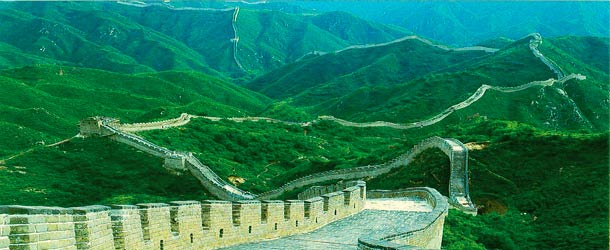A Yangtze river cruise will give you the chance to experience many of China’s most iconic landmarks, natural wonders and celebrated cities but out of everything you can see, there’s one man-made marvel which continues to wow visitors the world over more than any other, The Great Wall of China. Though The Great Wall does not pass close to the banks of the Yangtze, its well-preserved Badaling section is easily accessible from Beijing and most Yangtze cruises begin or end with a visit to the city before transferring by air to allow passengers to either start their cruise or return home.
 A long and winding history
A long and winding history
We’ve all seen those iconic pictures of the Great Wall where huge stone sections wind their way over green hills, occasionally broken up by watchtowers. However, the wall didn’t start off life like this and many of the earliest fortifications were made from tamped earth and wood. The wall’s been added to and reconstructed much over the years, with each consecutive dynasty shaping it to its ends, though it can trace its origins back to the 7th century BC, when a number of earth walls were built to protect the ancient states against invaders.
Throughout the centuries, these original walls were re-enforced and more were added, creating a succession of fortifications which eventually became known as the Great Wall. Things really got moving under the Qin Dynasty, when Qin Shi Huang unified China in 221BC and ordered the deconstruction of some sections and a comprehensive new building programme to protect his newly-formed empire from attacks from the north. Not much of this ancient ‘proto-wall’ remains however and though it was added to and expanded during the reign of the Han and Sui dynasties, a number of later dynasties held power in regions located north of the wall, so had no need to enhance it.
It wasn’t until the 14th century and the advent of the infamous Ming Dynasty that the Great Wall got its next major make-over. After suffering at the hands of the Manchurian and Mongolian tribes, Ming decided to fortify the border of northern China by building more walls. This was the brick and stone structure we know today, and most of the surviving Great Wall we now visit dates back to the time of the Ming Dynasty. In 2009, around 180 miles of wall dating back to the time of Ming was found, which had previously been submerged by sandstorms.
How long is it?
Stretching from Shanhaiguan in the East to Top Lake in the West, the Wall is a vast collection of structures. It’s not one continuous line and consists of a number of walls and trenches, as well as natural barriers, such as hills and rivers. The Ming section is constructed in this way and contains a staggering 3,889 miles of actual wall, with a total length of 5,500 miles. One particular archaeological survey took all of the Great Wall’s branches into consideration and found that if they were all laid end to end, they would measure a mind-boggling 13,171 miles.
Can it really be seen from space?
One of the oft-quoted facts about the Great Wall is that it can be seen from space. Well, there’s a lot of science to explain why this would not be possible, but put simply, if you’re capable of viewing a human hair from two miles away, you’ll be able to see the Great Wall from the moon. Good luck with that one! If you find yourself in the unlikely position of being in low Earth orbit however, there’s a chance you could see the wall and NASA states that it is just about visible under almost perfect conditions. However, you’d still need eye sight seven times better than normal, and you’re much more likely to see it with the aid of a very good camera and photos have indeed been taken from low Earth orbit to prove this.
Is it a wonder of the world?
Despite its advanced years, The Great Wall of China was not one of the Seven Wonders of the Ancient World. It is however, one of the New Seven Wonders of the World, an accolade it shares with the Taj Mahal, Chichen Itza, Christ the Redeemer, the Colosseum, Machu Picchu and Petra. The only remaining wonder of the ancient world is the Giza pyramid complex in Egypt.
By Simon Brotherton
Google



